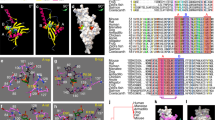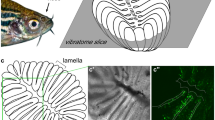Abstract
Experiments on isolated frog olfactory epithelium, using vital luminescent microscopy showed that the olfactory transduction of amyl alcohol is mediated by the intracellular cAMP signaling system. Increases in intracellular cAMP levels resulted from activation of adenylate cyclase type III via odorant-induced stimulation of G protein linked to it.
Similar content being viewed by others
REFERENCES
P. V. Avdonin and V. A. Tkachuk, Receptors and Intracellular Calcium [in Russian], Nauka, Moscow (1994).
E. V. Bigdai, V. O. Samoilov, and A. N. Komarov, “Studies of the involvement of the cAMP intracellular signal system in the olfactory transduction of camphors and amyl alcohol,” Ros. Fiziol. Zh. im. I. M. Sechenova, 85, No. 3, 412–418 (1999).
Yu. A. Vladimirov and G. E. Dobretsov, Fluorescent Probes in Studies of Biological Membranes [in Russian], Nauka, Moscow (1980).
O. S. Gladysheva, D. M. Kukushkina, V. A. Opritov, G. B. Sadikov, and I. M. Shvets, “ATP in the olfactory organ of the frog,” Tsitologiya, 26, No. 7, 788–793 (1984).
A. V. Minor and N. L. Sakina, “The role of cyclic adenosine-3′,5′-monophosphate in olfactory reception,” Neirofiziologiya, 4, No. 3, 415–422 (1973).
A. V. Minor, “The physiological mechanisms of operation of olfactory receptor cells,” in: Sensory Systems [in Russian], Nauka, Leningrad (1980), pp. 3–18.
I. P. Pavlov, “In Memory of Heidenhain,” in: The Complete Collected Works [in Russian], Academy of Sciences of the USSR, Second Edition (supplemented), Vol. 6, Moscow, Leningrad (1952).
A. F. Poglazov, M. V. Shubin, Yu. G. Skotselyas, V. A. Alimov, and Yu. A. Vladimirov, “Fluorimetric studies of the release of Ca2+ from lysosomes induced by phospholipase,” Biofizika, 20, No. 1, 69–72 (1975).
V. O. Samoilov, “General physiology and cell physiology,” Usp. Fiziol. Nauk., 25, No. 2, 23–28 (1994).
A. V. Skirkyavichus, Z. Yu. Skirkyavichene, V. M. Gavyalis, B. Yu. Yakaitis, and V. T. Balenta, “Electrophysiological studies of the magnitudes of olfactory receptor responses in typographic bark beetles to different concentrations of pheromone mixtures and their separate components,” in: Chemical Signals in Animals [in Russian], Nauka, Moscow (1982).
N. Sperelakis, The Physiology and Pathology of the Heart [in Russian], Meditsina, Moscow (1990), Vol. 2.
G. M. Frank, Biophysics of the Living Cell, Selected Works [in Russian], Nauka, Moscow (1982).
B. W. Ache and A. Zhainazarov, “Dual second-messenger pathways in olfactory transduction,” Curr. Opin. Neurobiol., 5, 461–466 (1995).
H. A. Bakalyar and R. R. Reed, “Identification of a specialized adenylyl cyclase that may mediate odorant detection,” Science, 250, No. 4986, 1403–1406 (1990).
D. Dixon, N. Brandt, and D. H. Haynes, “Chlorotetracycline fluorescence is a quantitative measure of the free internal Ca2+ concentration achieved by active transport. In situ calibration and application to bovine cardiac sarcolemmal vesicles,” J. Biol. Chem., 259, No. 22, 13737–13741 (1984).
S. Enomoto, M. Kashiwayanagy, and K. Kurihara, “Liposomes having high sensitivity to odorants,” Biochem. Biophys Acta, 1062, 7–12 (1991).
S. Firestein, G. M. Shepherd, and F. S. Werblin, “Time course of the membrane current underlying sensory transduction in salamander receptor neurons,” J. Physiol. (London), 430, 135–158 (1990).
S. Firestein, F. Zufall, and G. M. Shepherd, “Single odor-sensitive channels in olfactory receptor neurons are also gated by cyclic nucleotides,” J. Neurosci., 11, No. 11, 3565–3573 (1991).
S. Frings, J. W. Lynch, and B. Lindemann, “Properties of cyclic nucleotide-gated channels mediating olfactory transduction. Activation, selectivity, and blockade,” J. Gen. Physiol., 100, No. 1, 45–67 (1992).
S. Frings and B. Lindemann, “Odorant responses of isolated olfactory receptor cells are blocked by amiloride,” J. Membr. Biol., 105, No. 3, 244 (1988).
S. Frings and B. Lindemann, “Current recording from sensory cilia of olfactory receptor cells in situ. I. The neuronal response to cyclic nucleotides,” J. Gen. Physiol., 97, No. 1, 1–16 (1991).
S. Frings, S. Benz, and B. Lindemann, “Current recording from sensory cilia of olfactory receptor cells in situ. II. Role of mucosal Na+, K+, and Ca2+,” J. Gen. Physiol., 97, No. 4, 725–747 (1991).
V. Ganitkevich and G. Isenberg, “Caffeine-induced release and reuptake of Ca2+ by Ca2+-stores in myocytes from guinea-pig urinary bladder,” J. Physiol. (London), 458, 99–117 (1992).
I. C. Griff and R. R. Reed, “The genetics of olfaction,” Curr. Opin. Neurobiol., 5, 456–460 (1995).
M. Hallet, A. S. Schneider, and E. Carbone, “Tetracycline fluorescence as calcium-probe for nerve membrane with some model studies using erythrocyte ghosts,” J. Membr. Biol., 10, No. 1, 31–44 (1972).
M. Janiguchi, M. Kashiwayanagi, and K. Kurihara, “Enhancement of the turtle olfactory responses to fatty acids by treatment of olfactory epithelium with phosphatidylserine,” Brain Res., 647, 10–14 (1994).
D. T. Jones and R. R. Reed, “An olfactory neuron-specific G-protein involved in odorant signal transduction,” Science, 244, No. 906, 790–795 (1989).
M. Kashiwayanagi and K. Kurihara, “Odor discrimination in single turtle olfactory receptor neuron,” Neurosci. Lett., 170, No. 2, 233–236 (1994).
T. Kurahashi, T. Shibuya, and A. Kaneko, “Cyclic AMP-activated conductance in isolated olfactory receptor cells of the newt,” Jap. J. Physiol., 40, 193 (1990).
T. Kurahashi and K. W. Yau, “Tale of an unusual chloride current,” Curr. Biol., 4, No. 3, 256–258 (1994).
D. Lancet, “Properties of olfactory cilia and cAMP-mediated transduction,” Discuss. Neurosci., 4, No. 3, 68–74 (1987).
J. Lazarovitz, L. Ahaffir, U. Pace, E. Eckstein, J. Heldman, A. Avivi, and D. Lancet, “Olfactory Gs: a novel functionally distinct stimulatory GTP-binding protein,” J. Cell Biol., 109, No. 4, Part 2, 53a (1989).
G. Lowe and G. H. Hold, “Contribution of the ciliary cyclic nucleotide-gated conductance to olfactory transduction in the salamander,” J. Physiol. (London), 462, 175–196 (1993).
G. Lowe, T. Nakamura, and G. H. Gold, “Adenylate cyclase mediates olfactory transduction for a wide variety of odorants,” Proc. Natl. Acad. Sci. USA, 86, No. 14, 5641–5645 (1989).
B. P. M. Menco and A. I. Farman, “Ultrastructural evidence for multiple mucous domains in frog olfactory epithelium,” Cell Tiss., 270, 47–56 (1992).
A. Menrvse, G. Dodd, and T. M. Poynder, “Evidence for the specific role of cyclic AMP in the olfactory transduction mechanism,” Biochem. Biophys. Res. Commun., 77, No. 6, 672–677 (1977).
T. Nomura and K. Kurihara, “Similarity of ion dependence of odorant responses between lipid bilayer and olfactory system,” Biochem. Biophys Acta, 1005, No. 3, 260–264 (1989).
V. Pace, E. Hanski, Y. Salomon, and D. Lancet, “Odorant-sensitive adenylate cyclase may mediate olfactory reception,” Nature, 316, No. 2, 255–258 (1985).
E. Pleuffer, S. Mollner, D. Lancet, and T. Pleuffer, “Olfactory adenylyl cyclase: identification and purification of a novel enzyme form,” J. Biol. Chem., 264, No. 31, 18803–18807 (1989).
D. Restrepo, T. Miyamoto, B. P. Bryant, and J. H. Teeter, “Odor stimuli trigger influx of calcium into olfactory neurons of the channel catfish,” Science, 249, 1166–1168 (1990).
T. Sato, T. Hirono, M. Tenoike, and M. Takebayashy, “Two types of increases in free Ca2+ evoked by odor in isolated frog olfactory receptor neurons,” Bull. Electrotechn. Lab., 55, No. 9, 13–23 (1991).
J. S. K. Sham, “Ca2+ release-induced inactivation of Ca2+ current in rat ventricular myocytes: evidence for local Ca2+ signalling,” J. Physiol. (London), 500, No. 2, 235–295 (1997).
R. S. Winstock, H. N. Wright, A. M. Spiegel, M. A. Levinet, and A. M. Moses, “Olfactory distinction in humans with different guanine nucleotide-binding protein,” Nature, 322, No. 6080, 635–636 (1986).
F. Zufall, S. Firestein, and G. M. Shepherd, “Analysis of single cyclic nucleotide-gated channels in olfactory receptor cells,” J. Neurosci., 11, No. 11, 3573–3580 (1991).
Author information
Authors and Affiliations
Rights and permissions
About this article
Cite this article
Bigdai, E.V., Samoilov, V.O. Components of the Intracellular cAMP System Supporting the Olfactory Reception of Amyl Alcohol. Neurosci Behav Physiol 33, 89–94 (2003). https://doi.org/10.1023/A:1021139617470
Issue Date:
DOI: https://doi.org/10.1023/A:1021139617470




